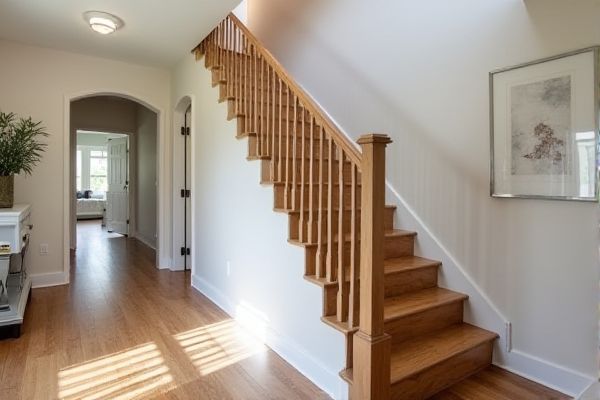
Straight run stairs offer a simple, direct path between floors, maximizing space efficiency and ease of use, while dog-leg stairs feature a 180-degree turn, providing a stylish solution that fits into tighter spaces without requiring a landing. Explore the rest of the article to determine which stair design best suits your home's architecture and your personal preferences.
Table of Comparison
| Feature | Straight Run Stairs | Dog-Leg Stairs |
|---|---|---|
| Design | Single straight flight | Two flights with a 90-degree turn |
| Space Efficiency | Requires more linear space | More compact, fits corners well |
| Safety | No landings, higher fall risk | Landing reduces fall risk |
| Installation Cost | Lower cost, simpler build | Higher cost due to complexity |
| Usability | Easy to climb and carry items | Landing can rest point, some navigation needed |
| Aesthetic Appeal | Simple, functional look | Architectural interest, versatile style |
Introduction to Staircase Types
Straight run stairs offer a simple, linear ascent with a single uninterrupted flight, maximizing space efficiency and ease of construction. Dog-leg stairs feature two flights connected by a landing, creating an L-shape that fits efficiently into corner spaces and provides a natural resting point. Both designs cater to different architectural needs and spatial constraints, influencing building aesthetics and functionality.
What Are Straight Run Stairs?
Straight run stairs consist of a single, continuous flight without any turns or landings, making them a straightforward and space-efficient choice for many architectural designs. These stairs provide a direct path between floors, often favored for their simplicity and ease of construction. Your selection of straight run stairs can optimize space and enhance accessibility in residential or commercial settings.
Overview of Dog-Leg Stairs
Dog-leg stairs consist of two straight flights connected by a landing, creating a 180-degree turn that efficiently utilizes space in your home. This design offers a compact alternative to straight run stairs, making it ideal for narrow or constrained areas while maintaining safety and ease of navigation. The landing provides a resting point and reduces the risk of falls, enhancing overall functionality in multi-story layouts.
Space Efficiency: Straight vs. Dog-Leg Stairs
Straight run stairs typically require more linear space, making them less efficient for compact areas. Dog-leg stairs maximize space by incorporating a landing and a 180-degree turn, fitting easily into corners or narrow layouts. If optimizing your floor plan is a priority, dog-leg stairs offer better space efficiency while maintaining safe and comfortable access between floors.
Structural Design Differences
Straight run stairs feature a continuous, linear flight that requires consistent support through stringers or cantilevered steps, offering straightforward load transfer to the foundation. Dog-leg stairs incorporate two straight flights connected by a landing, necessitating intermediate supports and more complex framing to accommodate the change in direction. The structural design of dog-leg stairs often involves additional beams and columns to handle the torsional forces generated at the landing junction.
Aesthetic Appeal and Style Considerations
Straight run stairs offer a clean, minimalist aesthetic that complements modern and contemporary interior designs by emphasizing linearity and spaciousness. Dog-leg stairs introduce visual interest and architectural character through their L-shaped configuration, making them ideal for traditional or transitional styles that benefit from a dynamic staircase centerpiece. Both styles can be customized with materials like wood, metal, or glass to enhance their stylistic impact and overall harmony within the living space.
Cost Comparison: Installation and Materials
Straight run stairs typically cost less to install and require fewer materials due to their simple design and minimal landings, making them budget-friendly for straightforward layouts. Dog-leg stairs involve more complex construction with intermediate landings and additional support, increasing both material usage and labor expenses, thus leading to higher overall costs. Choosing between the two depends on your space configuration and budget constraints, with straight run stairs offering a cost-effective option and dog-leg stairs providing enhanced functionality at a premium price.
Safety Factors and Accessibility
Straight run stairs provide a clear path with consistent step pattern, reducing trip hazards and improving safety for users, especially those with mobility challenges. Dog-leg stairs incorporate a landing that breaks the flight, which can offer a resting point and enhance accessibility for individuals needing periodic breaks. Your choice between these designs should consider the stairway's expected use, as straight run stairs offer straightforward navigation while dog-leg stairs may better accommodate limited space and provide safer turning points.
Suitability for Residential and Commercial Buildings
Straight run stairs offer simplicity and space efficiency, making them ideal for both residential homes and commercial buildings where direct, quick access between floors is needed. Dog-leg stairs provide a more compact footprint and enhanced safety by breaking the flight with a landing, making them suitable for residential settings with limited space and commercial buildings requiring controlled traffic flow. The choice depends on architectural design, space constraints, and user convenience in each building type.
Conclusion: Choosing the Right Staircase
Straight run stairs offer simplicity and ease of installation, making them ideal for spaces requiring direct, unobstructed access. Dog-leg stairs maximize space efficiency by fitting into compact layouts with a 180-degree turn, suitable for tighter floor plans. Selecting the right staircase depends on available space, design preferences, and functional requirements to balance aesthetics and practicality.
 homyna.com
homyna.com